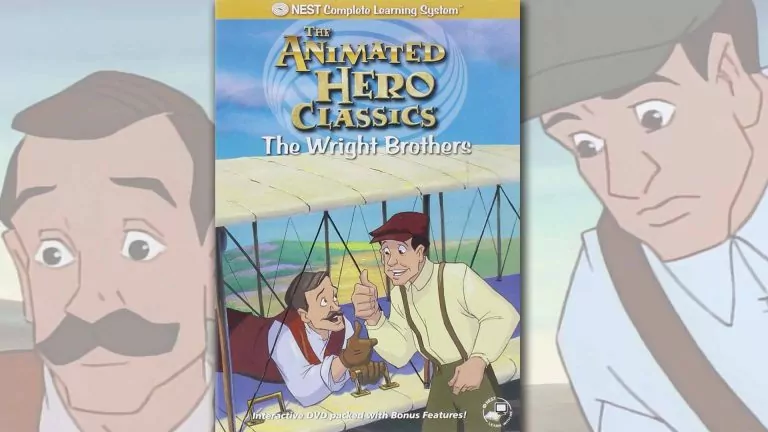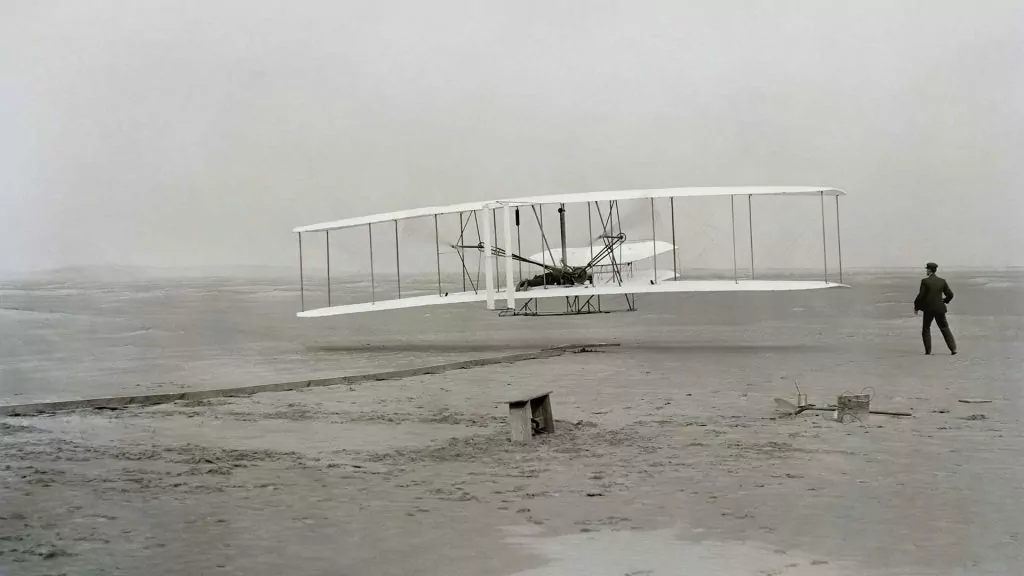The Gift of Flight: Two brothers' determined quest
As stories go, this one sounds as if it comes from Through the Looking Glass: and what Alice found there, the classic story by Lewis Carroll where everything is backward. That is how this plot goes: amateur technologists succeed with a few dollars of their own money while big science, with a big budget, fails.
And the improbable scenario continues. Even when the amateurs succeed, establishment science and the national media refuse to acknowledge that fact. They don’t want it to be true, so it isn’t. Then, when belatedly everyone knows that the amateurs have indeed achieved what they have long claimed, the government honors the scientist who failed! This isn’t a nihilist plot by Franz Kafka, this is history. And these events have much to tell us about the impact of vested interests on scientific research and public honors.
Langley gets the government onboard
In hindsight, it is obvious that the time was ripe for a breakthrough in heavier-than-air flight. During the mid-eighteenth century Swiss mathematician Daniel Bernoulli had developed equations to describe the flow of fluids. Since air currents flow in the same fashion as fluids, similar equations apply. Thus it was as easy to study the flow of air over an object as it was to study the flow of water. In both instances, as the speed of flow increases, the pressure decreases. If a current moves over an object with a curved upper and a flat lower surface, then the flow above the object moves faster than the flow below. As a consequence, the pressure exerted on the upper surface is less than on the lower surface. With reduced pressure above, the object will move upward.
Such theory, towards the end of the nineteenth century, provided the basis for the new science of aerodynamics. The object with the curved upper surface was an airfoil or wing, and this was the structure that would carry heavier-than-air flight into reality.
Some scientists at the time insisted that such a phenomenon was impossible. There were others, however, like Samuel Pierpont Langley (1834-1906), who were actively involved in aerodynamic research. Indeed, this American astronomer and physicist had published a treatise in 1891 entitled Experiments in Aerodynamics. Five years later he designed and successfully flew an unmanned steam-powered model airplane. The machine flew 0.8 km (0.5 mile) in one and a half minutes. Based on this success, he applied for, and received, a grant of $50,000 to scale up his model to pilot-carrying size. That grant represented a huge fortune. Obviously there were influential people in government and science who believed that heavier-than-air flight was possible.
Enterprising brothers
Some bachelor entrepreneurs in Ohio also knew that heavier-than-air flight was possible. They had observed buzzards, and other feathered flight success stories (birds), and they decided that it might be fun to try their hand at this project. Wilbur and Orville Wright (born 1867 and 1871 respectively) were the third and fourth sons of Bishop Milton Wright of the United Brethren Church. Their Christian commitment translated into a joyous and lively curiosity about nature. They refused, however, to pursue any research or work on Sunday.
Glider pioneer Otto Lilienthal (1848-1896) in 1894, about to test one of his glider designs.
Although bright, these men never actually graduated from high school. Nevertheless, they loved a mental challenge. Their main source of income during the late 1890s was as bicycle shop owners. Not only did they sell machines, they also manufactured them. This business was somewhat seasonal in nature which left time during the off-season for the brothers to pursue other interests. Moreover, the tools and know-how from bicycle manufacture would prove useful for developing another technology.
The Wright brothers’ interest in heavier-than-air flight was piqued by the news in 1896 that German Otto Lilienthal had been killed in a crash of one of his gliders. Since 1891 this man had experimented with various glider designs and everyone recognized that he had significantly advanced the science of aerodynamics. Lilienthal was the first person to ride an airborne glider and by the time of his death he had about 2,500 flights to his credit.
On to Kitty Hawk
By the summer of 1899, the Wright brothers had researched the topic and they understood what problems needed to be solved for success to be achieved. Next, upon inquiry, they discovered that the coastal sand dunes near Kitty Hawk, North Carolina, were a promising place to fly gliders. This identification was based on the unusually strong and steady winds which were typical of that area. Kill Devil Hills near Kitty Hawk thus became the site of their early experiments.
The Wrights set out, first of all, to find a glider design that was stable and reliable in the air. Others had made gliders before them, but none that were well controlled – balancing a “flyer” seemed easy but it really wasn’t. When the wings were arranged in a V pattern with the passenger at the lowest point, the system performed adequately in calm air but got knocked back and forth, oscillating in wind. Alternatively, when the center of gravity was located in front of the wings, there was constant up and down undulation.
In view of these already identified problems, the Wrights determined to build a glider that would allow the operator to restore balance. They thus set out to design wings that could be manually warped – twisted slightly – when the pilot shifted his weight so he could make ongoing inflight adjustments, somewhat like birds do by twisting and tipping their wings. Their objective was to obtain from the wind, the forces needed to restore balance. When they tried out their design at Kitty Hawk in October 1900, they discovered that their device did not have enough lift to carry a man. These trials did however suggest that they were on the right track as far as balance and control were concerned.
The brothers returned to Kitty Hawk during July of 1901. They now used a wing shape that Otto Lilienthal had developed, and also relied on his lift calculations to determine how big the wings should be. This design performed much worse than their previous year’s model. They rebuilt the glider and still it insisted on spinning. After further modifications, the balance was improved but the lifting capacity was still most disappointing.
The Wrights realized that “the calculations upon which all flying-machines had been based were unreliable and that all were simply groping in the dark.” Even Samuel Langley’s data they concluded was “little better than guess-work.” (All quotes are from “the Wright Brothers’ Aeroplane” by Orville and Wilbur Wright published in the Sept. 1908 edition of The Century Magazine.)
World’s first wind tunnel
The Wrights returned home to Ohio, determined to generate their own data. To this end, they devised the world’s first wind tunnel. This was a contraption six feet long that they set up in their bicycle shop. The brothers had taken up aeronautics “as a sport.” Now they reluctantly undertook real research. Soon they found the work so fascinating they were “drawn deeper and deeper into the project.” Using the wind tunnel, they made systematic measurements of standard surfaces,
...so varied in design as to bring out the underlying causes of differences noted in their pressures. Measurements were tabulated on nearly fifty of these at all angles from zero to 45 degrees, at intervals of 2.5 degrees.
Based on these new data, they ran successful trials of a new glider during the fall of 1902. With a stable device, and with accurate data on lift, they were now ready to build a powered flyer. The two hurdles yet to overcome were propeller design and building a suitable lightweight engine.
Early in 1903, they turned their attention to propeller design. It wasn’t as easy as they had expected. As they later reported:
What at first seemed a simple problem became more complex the longer we studied it. With a machine moving forward, the air flying backward, the propellers turning sidewise, and nothing standing still, it seemed impossible to find a starting point from which to trace the simultaneous reactions.
After much agonizing, they apparently sorted out the problems. The result of their calculations was highly satisfactory propellers.
The last requirement was a small internal combustion engine. This they built in their bicycle shop. The cost of the entire flying machine was about $1000. It featured the propellers behind the wings, the rudder in front, and wings covered with “Pride of the West” muslin, a cotton fabric manufactured especially for ladies’ underwear.
The fateful day
Samuel Langley’s Aerodome was to be launched, catapult style, off the roof of a houseboat. But both his 1903 trial flights ended up in crashes.
On October 7, 1903, Samuel Langley’s scaled up airplane design crashed. He asked for, and received, more government funds to try again, but on December 8 his device crashed again.
Then on December 17 at Kitty Hawk, Orville Wright made the first successful powered flight. Five people witnessed the event. The fight lasted 12 seconds and extended only 120 feet. Later in the day, a flight of 852 feet was achieved. Heavier-than-air flight was now a reality and modern life would never be the same.
The almost universal response of their fellow Americans was to deny that anything had happened. The media refused to take any notice of this achievement. By the fall of 1905 the Wrights were now airborne for one-half hour at a time. They practiced flying in Ohio, above a large field with public roads and a railroad nearby. Thousands of eyewitnesses testified to the reality of this success story. Reporters refused to believe firsthand accounts nor even to investigate for themselves. In January 1906, Scientific American insisted in print that the story of flight was a hoax since no newspapers had reported it. Finally, in 1908, President Theodore Roosevelt ordered flight trials at Fort Myers. As a result, the brothers signed a contract to deliver airplanes to the US Army. However, public acclaim only came after Wilbur carried out a “public” flight in France on August 8, 1908. Now the age of flight had really dawned. Within less than a year, on July 25, 1909, Louis Bleriot became the first person to fly across the English Channel.
Wright Air Force Base?
The relationship of the Wrights with the American scientific establishment was never cordial. After a dispute with the Smithsonian Institute in 1928, the only model of the original flyer was sent to England for display. There it remained until 1948, the year Orville Wright died. His older brother had died many years earlier. Meanwhile, significant honors were accorded Langley rather than the Wrights. Langley Air Force Base was established in 1916 to honor this “American air pioneer.” From 1931 to 1995 the world’s most prestigious wind tunnel operated at the Langley base. This site is also famous for its NASA research laboratory located there. In addition, the nation’s first aircraft carrier was also named after Langley.
The world nevertheless remains deeply indebted to these two Christian bachelors who used their God-given talents for the benefit of their fellow man. Their objective was not fame and fortune, but rather the joy of discovery of God’s creation. Thus just over one hundred years later, Christians can give special thanks for the testimony afforded by the lives of these interesting men.
Dr. Margaret Helder is the author of “No Christian Silence on Science.”...












